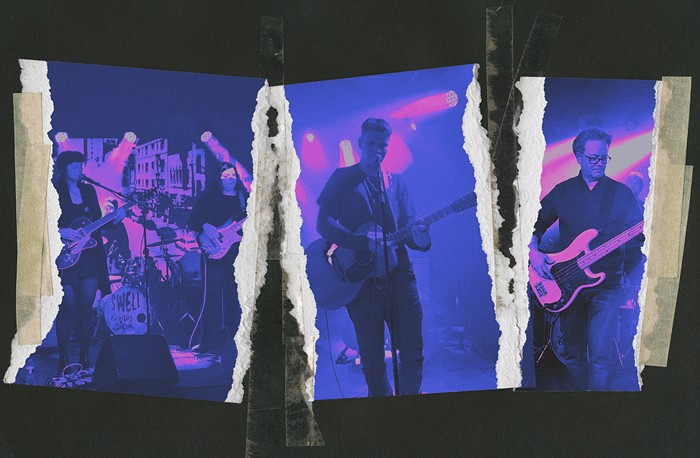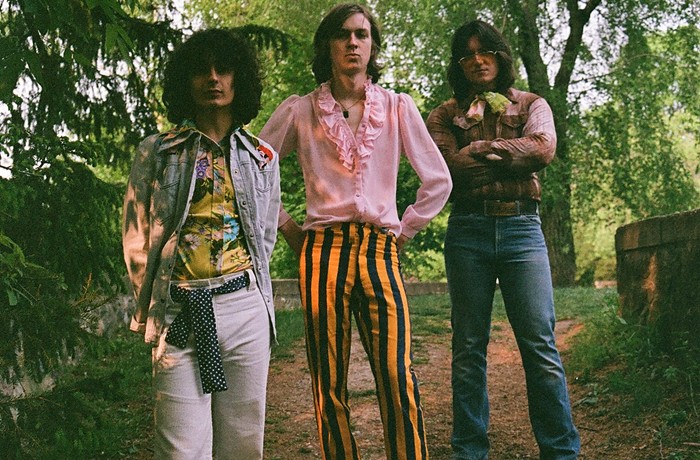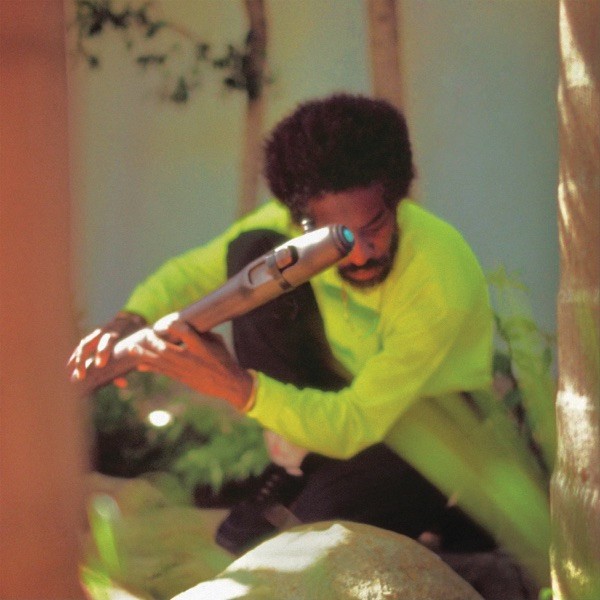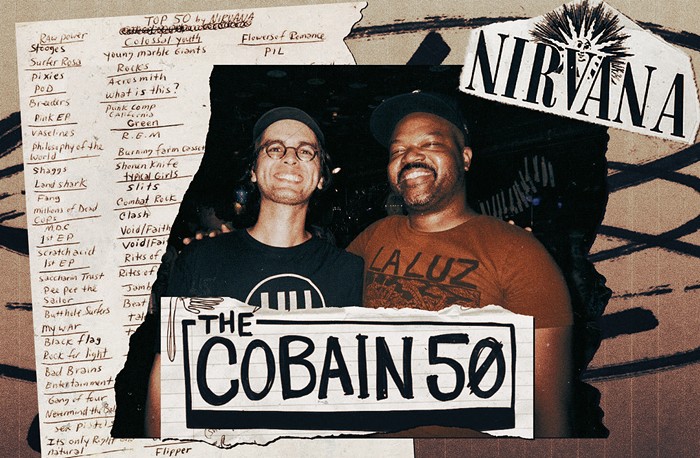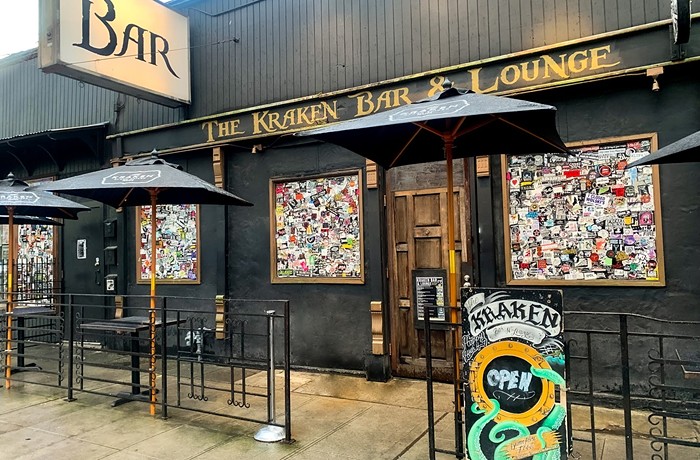GNARLS BARKLEY
St. Elsewhere
(Downtown)


 1/2
1/2
Sounds like someone slipped some PCP into the crunk juice. Internet poster boy Danger Mouse's much-anticipated and heavily downloaded collaboration with Goodie Mob founder Cee-Lo sounds sane enough for a few minutes, what with #1 hit "Crazy"'s catchy bounce and plaintive vocals, but things start to get deliciously weird from there.
Danger Mouse is no stranger to contrasts, having made his name laying tough-as-nails Jay-Z vocals over the best bits from the Beatles' White Album. His stuttering lo-fi beats and slightly seasick melodies always add a bit of edge to clean-cut pop structures, and the Dirty South aesthetic of Goodie Mob and friends has always teetered on the brink, yet on St. Elsewhere the wheels have finally come off. What kind of paranoid freak would cover the Violent Femmes' "Gone Daddy Gone," then throw down a stuttering, schizoid rap about Transformers? What sort of cruel person writes a dreamy, elated song fragment like "Feng Shui," then cuts it off after precisely 90 seconds?
"St. Elsewhere" sounds very much like someone's mind coming apart. Let me be clear—this is not a bad thing. The flip side of funk on the dance floor has always been funk in a straitjacket, and everyone from Funkadelic to Outkast has thrown a little crazy into the mix. This record has definitely earned its own cell in the asylum. MATT CORWINE
RJD2
Magnificent City Instrumentals
(Decon)



RJD2 is one of the few practitioners of instrumental hiphop that won't quickly lull me into a shallow, troubled sleep state. While it's not an official stand-alone album, I was nonetheless eager to listen to the instrumental version of his recent collaboration with one of the West Coast's most nimble-tongued MCs, Aceyalone; Magnificent City Instrumentals doesn't disappoint either, with "All for U" seemingly picking up right where "1976" from RJ's Since We Last Spoke left off. A mix of pulsating bass, burbling snatches of soul, submerged guitar and vintage synths, MCI isn't quite as wide open as SWLS, instead reflecting the twitchy claustrophobia of the titular megalopolis. The eclectic jumble of sounds, however, perfectly fits the city pictured on the cover, composed entirely of landmarks like the Eiffel Tower, the Space Needle, and the Cristo Redentor.
I'd have to say I prefer the instrumental versions, as I found Acey serviceable, but rather bland on the originals. Without the MC's inducements, it's easier to hear the intricacies of RJ's swinging, bouncing compositions. The mood weaves and wanders in unexpected directions, but the sounds never hit wide of the mark; the gold-lamé funk of "Fire" segues nicely into the machine-shop rock of "Cornbread, Eddie & Me," just as RJ's blippy grime beat on "Mooore" flows easily into the "Tour De France"-like electro of "Supahero." While lacking the thematic cohesion with which RJ has infused his LPs, MCI makes for compelling theme music to score your grocery trips. Swagger to go. LARRY MIZELL JR.
GROWING
Color Wheel
(Mega Blade)


 1/2
1/2
For a band that's apt to compress the nuances of Robert Fripp's arch-lightning guitar arpeggios together with the subterranean rumble of SUNN 0))) and the swirling, churning overtones of Phill Niblock's work, Growing have provided a listening experience that's surprisingly concise with Color Wheel. This is a real listener's record, and while it's trippy enough for headphone-panning fireworks, the album really resonates when played loudly for all its subtlety to be rendered in full.
Growing have been cloudily obscuring their heavy guitar textures through an array of effects for some time, but Color Wheel's immediate defining feature is that its guitars actually sound like guitars. The album's opening, "Fancy Period," begins with a shimmering synth pattern before fracturing into a disjointed beat of irregular cuts of sound. The epic metal fuzz track "Friendly Confines" concludes with a banjo-like coda.
Previous Growing efforts have tended to feature sublime waves of treated sound that distort any sense of time. With Color Wheel, the band seem more comfortable to let the innards of their sonic constructions show, and the result hints more at a narrative experience, but it remains just as immersive as their earlier releases. The 16-minute "Blue Angels" is the centerpiece of this new territory. Beginning with a lulling roll of subdued tones, the track runs up against a wall of bass before resolving into a melody made up of a guitar metamorphosing into a facsimile of electronic bagpipes, which ring out into a sort of endless, imaginary sky. SCOTT GOODWIN
ANE BRUN
A Temporary Dive
(V2)



Call her the Anti DiFranco. The Norwegian-born, Sweden-residing folky Ane Brun has an artful, almost detached way of singing, which imbues her mostly depressing lyrics with power rather than self-pity. "Rubber & Soul" opens with the striking lines, "In my mind I'm crawling on your floor/Vomiting and defeated," yet Brun doesn't oversell the words. Even when she goes for a simplistic rhyme, the beauty of her voice and the distracted way she uses it make the lyrics come across as poignant rather than obvious. That's not to say Brun isn't emotional in her delivery; she's just not overt. Imagine an English-folk-loving Billie Holiday.
Brun's second CD, A Temporary Dive, features her crisp acoustic-guitar playing at the center of the music, which is minimally decorated with delicate percussion ("Balloon Ranger"), glockenspiel ("Temporary Dive"), or unobtrusive strings, as on "My Lover Will Go" and the revamped Henry Purcell aria "Laid in Earth." Two other highlights include duets with Syd Matters ("Little Lights") and Ron Sexsmith, where the two long faces sing an outright happy love ode in "Song No. 6." CHRISTOPHER PORTER
YELLOW SWANS
Psychic Secession
(Load)



Those familiar with the Yellow Swans' particular brand of industrial noise will find all the familiar elements intact, save for the almost-decipherable vocals and improved production qualities. Except the first third of the 20-minute white-noise wash of the opening track, "True Union," as well as some atmospheric passages throughout, emphasis here is placed on rhythm by way of muffled drum-machine throb that churns in and out of the sonic spectrum. Abruptly pulsating frequencies, too, account for much of the rhythm of Psychic Secession, and sometimes it all converges for something akin to tangible song structure. Relative to most Swans material, "I Woke Up" is a danceable track, but it's far from lighthearted, and levity is nowhere to be found in this recording. Whether via the creepy, vocodered vocals or the minor-key frequencies that ebb and flow throughout the murky soundscape, a feeling of impending bad things pervades the album, as is often the case with such formless aural fracases. The title track begins with (Stranger freelancer) Sam Mickens's unmistakable vocal contribution, which accounts for the only intelligible words on Secession; otherwise, it's all in the form of heavily affected whispering or muffled nightmare commentary. But just livke the more grating frequencies of Secession, the voices never clatter on for too long. While Yellow Swans often employ the same techniques as fellow noise purveyors Wolf Eyes, their reserve provides for a more palatable journey through the noise universe. GRANT BRISSEY
VARIOUS ARTISTS
Journey Into Paradise: The Larry Levan Story
(Rhino)



From 1977 to 1987, Larry Levan was the DJ at New York's Paradise Garage, where disco music licked its wounds, mutated and turned into the fertile soil that later gave rise to what we now call house music and techno. While Studio 54 was churning out clichés up the street, and hiphop was beginning to emerge further uptown, the Paradise Garage thrived in their shadows. Catering to a hardcore following of black and Puerto Rican gay men, arty downtown types, hippies, and freethinkers, Levan evoked nearly religious admiration with his genre-bending, spaced-out sets.
Journey Into Paradise features full-length versions of some of Levan's best remixes, as well as the records he played so much (and so well) that they became his own. The tracks collected here capture the era after the so-called "death of disco"—from 1979, the year thousands of smug racists burned their disco records at Comiskey Park, to 1986, when the Reagan administration began its too-little-too-late response to the AIDS crisis. In this climate of hate and fear—when people never knew when they would get beaten up for how they lived, or which of their friends would die next—they stayed up all night and danced to music that was unabashedly positive and forward-thinking, in a private club that seemed like the only place they could feel safe.
The political dimension aside, Levan's approach to music did more than soothe the pain of marginalized people—it also helped shape both the deep spirituality that underpins house music and the sonic wizardry that lives on today in techno. MATT CORWINE
MAMMATUS
Mammatus
(Holy Mountain)



F/i
A Question for the Somnambulist
(Strange Attractors Audio House)




Hawkwind—so much to answer for. Fortunately, many of the musicians inspired by those English space-rock avatars have done the originators proud. Cases in point: Mammatus and F/i. Mammatus are a Cali quartet whose self-titled debut fires all of its guns at once and explodes into space. "The Righteous Path Through the Forest of Old" kicks off Mammatus with tear-ass momentum, like a fleet of Hells Angels ripping through a wind tunnel on Harley Davidson's finest hogs. "The Outer Rim" radiates shimmery drones that are buttressed by devotional chants and mesmerizing bongo slaps; it's the sort of stoned, nebulous sojourn every good psych-rock record should feature. "Dragon of the Deep Part One" is a rambling, Bronto-stomp of acid-fried, Monster Magnet doomadelia. Only problem here is the meandering 22-minute finale, which they should've halved. Otherwise, Mammatus's debut is a banquet of voluptuously bruising psych rock.
Since 1983, F/i have been burnishing Hawkwind's legacy of fiery propulsions while also extrapolating on the mantric excursions and electronic explorations of German groups like Neu!, Cluster, and Can. Their latest disc, A Question for the Somnambulist—originally issued in 2003—now gets graciously reissued by Portland's excellent Strange Attractors Audio House. Over 20 years into their existence, F/i haven't waned at all; nor have they really deviated much from their early sound. But why mess with an approach as righteous as theirs? These Milwaukee heads still deliver the soaring, serpentine instrumental jams that could launch a dozen seasons of Star Trek. Hawkwind—and Gene Roddenberry—would certainly approve. DAVE SEGAL
Fuel on Fire
(Kill Rock Stars)



Olympia/Seattle trio the Old Haunts tread a punk-history-thick terrain somewhere between the art-attack itchiness of Television and the adrenalized stride of X. Their new second full-length, Fuel on Fire (on Kill Rock Stars), follows the American gothic punk of last year's Fallow Field (props for discography-spanning alliteration) with admirable, well-honed consistency. The record's promo line boasts of the musicians' collective membership in 14 bands over the years and, indeed, you can hear their well-oiled musical synapses firing.
The playing is artful and deceptively intricate, but maintains a thoroughly frayed and spontaneous energy throughout. The bone-dry, spidery guitar lines, monster-bellied, darkly melodic bass, and train-track-laying drums all cram lots of intrigue and off-kilter weirdness into songs that still manage to sound completely sparse and heavy. Frontman Craig Extine's harried singing, while landing a little monochromatic and occasionally veering into fake-British-accent territory, is a solid pure punk-rock voice, sometimes reminiscent of the most bug-eyed Tom Verlaine yelping.
Additionally, over the course of Fuel on Fire, the Old Haunts manage to gesture toward a wide variety of reference points without ever diluting their bedrock musical identity. The disc's songs embrace elements of flint-edged country, waltz-time circus music, and avant blues with subtlety and aplomb, but none of these genres ever overwhelms the clear-eyed, sweat-browed art punk of this inveterate raw-power trio. SAM MICKENS
YEAH YEAH YEAHS
Show Your Bones
(Interscope)



Forget the stupid haircuts, the tsunamic publicity bum rush, the Squeak E. Clean/Spike Jonze connections, and anything else that might offend your purist indie sensibilities. Just listen: It's all there in the first three beats of the album, a wink and a nod, a salute to their intentions—Show Your Bones opens with a quick riff on "We Will Rock You," and then proceeds to do exactly that.
More flashily produced than Fever to Tell, Yeah Yeah Yeahs' Show Your Bones is as infectious as it is hooky, with Karen O's gasp-y phrasings sounding like Nancy Sinatra–via–Iggy Pop, and guitarist Nick Zinner and drummer Brian Chase keeping things swinging frantically from bouncy to screamy to dance-y to chunky throughout.
"The Sweets" is a nice, sparse throwback to "Hello Tomorrow," the dreamy Adidas commercial that signaled groundswell changes for the band; "Honeybear" kicks off with an almost electroclash beat before slamming into power-chord goodness; "Way Out" is officially my song for springtime, starting off nice and bubbly and Grandaddy-esque before exploding in a Joan Jett/Beavis & Butthead rockathon.
So, yeah, you'll be hearing this booming from Urban Outfitters all summer long, but if you let the hype stop you from rocking this one, you're the one losing out, buddy. CHAS BOWIE

